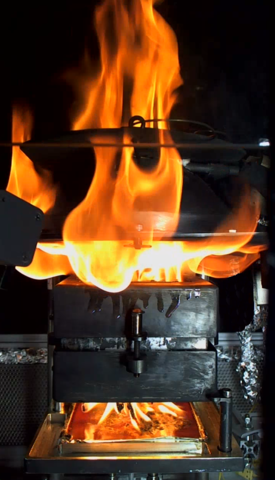Summary
This project investigates the potential of functional barriers — defined as any layered material that reduces heat and mass transfer in a multi-layer product exposed to fire — to enable low-flammability products without relying on flame retardants.
Using the ASTM E3367 test standard (an output enabled by this project) and full-scale testing, this project examines how well ASTM E3367 predicts full-scale performance in multi-layer products that include a functional barrier. This approach reduces the time, cost, and infrastructure needed for product evaluation. Functional barriers provide an alternative for compliance with fire testing standards and regulations in applications where flame retardants have been restricted or banned, while also avoiding the potential environmental and health concerns associated with flame retardants use.
Description

Objective
To enable low-flammability products which do not contain flame retardants by 1) providing a methodology and guidance to assess the performance of functional barriers at bench-scale, 2) enabling the development of functional barriers with improved performance, and 3) exploring the use of functional barriers for multi-layer products in critical applications.
Technical Idea
The new technical approach involves developing low heat release rate multi-layer products using functional barriers, where a functional barrier is any layered material that can reduce heat and mass transfer in a multi-layer product exposed to fire. For example, in a wall assembly, the exterior siding can function as a barrier, protecting the exterior insulation from an outdoor fire, even though the siding itself is not conventionally categorized as a fire barrier. The project focuses on multi-layer products commonly found in residential buildings, such as upholstered furniture, wall and roof assemblies, as well as products used in transportation, like structural composite panels.
NIST has previously demonstrated that fire barrier fabrics are effective and safe solutions for reducing fire losses in multi-layer products like soft furnishings. However, developing new fire barrier technologies and fire barrier-containing products currently depends on expensive and time-consuming full-scale tests, due to the lack of reduced-scale tests that can predict full-scale performance with sufficient accuracy. In addition to scaling challenges, a major issue with existing reduced-scale tests is their inability to accurately capture the effects of fire barriers on mass transfer of gaseous and liquid products produced during pyrolysis or melting of the materials.
To address this gap, NIST has recently developed a bench-scale test based on the cone calorimeter (ASTM E3367), known as the “Cube test.” The Cube test is designed to measure heat release rate while considering the mass and heat transfer of pyrolysis products within a representative cross-section of a multi-layer product, potentially incorporating a functional barrier.
ASTM E3367 yields additional information to cone calorimetry, including propensity of the product to generate a pool fire and propensity to burn-through in presence of fire barriers. These additional data have been proved to be useful to predict the full-scale performance of multi-layer products containing fire barriers. A strong linear correlation (R2 > 0.97, where R is Pearson’s correlation coefficient) has been found between selected performance parameters at full-scale (i.e., peak of heat release rate, time to peak of heat release rate and average heat release rate before ignition of liquid products) and ASTM E3367 parameters.
This project will further develop the Cube test to (a) examine its correlation with full-scale testing of multi-layer products, (b) support the development of functional barriers with improved performance, and (c) explore the application of functional barriers in multi-layer products for high-impact fire safety applications.
Research Plan
The primary objective of this project is to provide accurate bench-scale fire performance metrics to reduce the burning hazard of multi-layer products which include a functional barrier. The project will consist of three main tasks:
Task 1. Cube Test Development: This task focuses on developing the Cube test, a bench-scale tool to measure fire performance metrics for multi-layer products containing functional barriers. The Cube test is used to identify and quantify physical mitigation processes — namely reductions in heat and mass transfer — that allow functional barriers to limit fire growth. Activities related to the standardization of the Cube test as ASMT E3367 and development of the standard, are being carried out.
Task 2. High Performance Barriers: This task involves screening new materials and design solutions for functional barriers using the Cube test. The focus is on evaluating newly developed commercial products and NIST-prepared samples. NIST samples are created by modifying commercial products with various treatments designed to reduce mass and heat transfer, such as intumescence. The most promising functional barriers identified through Cube testing are validated at full scale to confirm the Cube test predictions.
Task 3. Mult-layer Products: This task aims to extend the use of functional barriers to multi-layer products in high-impact applications identified by the NIST research roadmap. The performance of these multi-layer products is assessed through the Cube test and, in a limited data set, full-scale testing. Full-scale testing validation is conducted to ensure proper Cube test-to-full-scale correlation.
Major Accomplishments
- ASTM E3367: a new standard test that allows to measure at bench-scale the reaction to fire of multi-layer products is an output enabled by this project.
- Fire-safe upholstered furniture (i.e., upholstered furniture resisting cigarette ignition and suppressing flash over) was produced by properly selecting (via ASTM E3367) and combining fire barrier fabrics.

